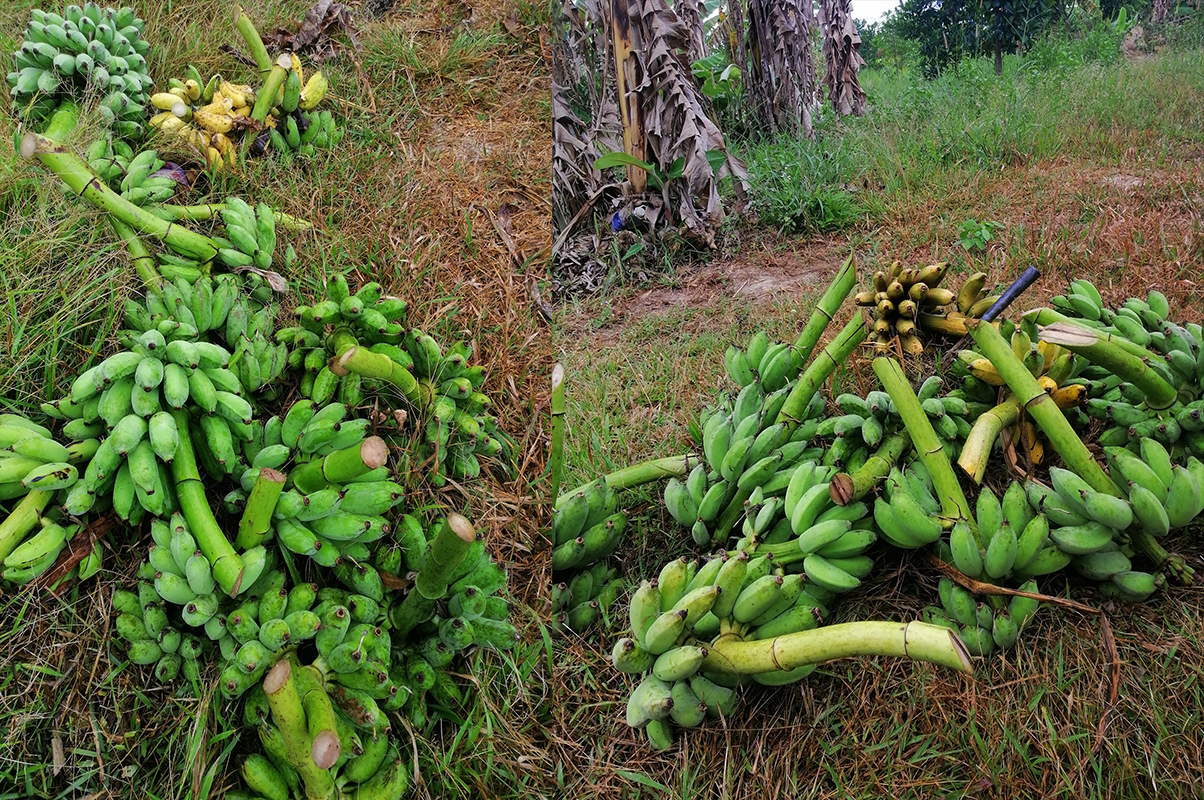ກ້ວຍນ້ຳ
Kluai Nam Wa
Musa acuminata subsp. burmannica N.W.Simmonds
ພືດ
ພືດລົ້ມລຸກ
ຜັກ ແລະ ພືດລົ້ມລຸກ
Musa × sapientum var. angao Quisumb.
Musa × sapientum var. baca Quisumb.
Musa × sapientum var. binutig N.G.Teodoro
Musa × sapientum var. canara N.G.Teodoro
Musa × sapientum var. canaya Quisumb.
Musa × sapientum var. champa (Baker) Baker
Musa × sapientum var. cinerea (Blanco) N.G.Teodoro
Musa × sapientum var. compressa (Blanco) N.G.Teodoro
Musa × sapientum var. cubensis N.G.Teodoro
Musa × sapientum var. dacca (Horan.) Baker
ນິເວດວິທະຍາ
ລຽບແມ່ນ້ຳຂອງພາກເໜືອ
ທົ່ງພຽງວຽງຈັນ
ເຂດລຽບແມ່ນ້ຳຂອງພາກໃຕ້

ການນຳໃຊ້
ພືດເປັນຢາ
ອາຫານ: ໝາກກ້ວຍນ້ຳມີປະໂຫຍດຫຼາຍ ຕັ້ງແຕ່ໝາກດິບ ທີ່ແກ່ດີກໍ່ໃຊ້ປະໂຫຍດເປັນກ້ວຍສາບ ແລະ ແປ້ງກ້ວຍ. ໝາກກ້ວຍໃກ້ຈະສຸກກໍ່ສາມາດເຮັດກ້ວຍປີ້ງ ແລະ ກ້ວຍທອດ. ໝາກກ້ວຍສຸກກໍ່ສາມາດກິນສົດ, ແປຮູບເປັນກ້ວຍບົດເພື່ອເປັນອາຫານເດັກນ້ອຍ, ເປັນສ່ວນປະສົມຂອງເຂົ້າຫນົມ ເຊັ່ນ: ເຂົ້າໜົມກ້ວຍ, ກ້ວຍແຜ່ນ ແລະ ກ້ວຍຕາກ/ອົບ. ກ້ວຍສຸກງອມກໍ່ໃຊ້ເຮັດເປັນກ້ວຍກວນ.
ຢາ: ໝາກກ້ວຍສາມາດຮັກສາໄດ້ຫຼາຍພະຍາດດັ່ງນີ້:
ແກ້ເຈັບທ້ອງຊ້ຳເຮືອ: ການຮັບປະທານກ້ວຍສຸກສາມາດຮັກສາອາການຖອກທ້ອງໄດ້ ເນື່ອງຈາກໃນກ້ວຍມີທາດເພັກຕິນ (Pectin) ເຊິ່ງເປັນເສັ້ນໃຍອ່ອນນຸ່ມ ຊ່ວຍເພີ່ມກາກອາຫານໃນລຳໄສ້ ເມື່ອກາກອາຫານມີຫຼາຍຈະໄປກະຕຸ້ນລຳໄສ້ໃນເກີດການຂັບຖ່າຍໄດ້ດີຂື້ນ.
ແກ້ຖອກທ້ອງ: ໃຫ້ຮັບປະທານກ້ວຍດິບ ເພາະໃນກ້ວຍດິບມີສານຝາດຊື່ ແທນນິນ (Tannin) ທາດນີ້ຈະຊ່ວຍຢັບຢັ້ງການຈະເລີນເຕິບໂຕຂອງເຊື້ອພະຍາດ ເຮັດໃຫ້ອາການຖອກທ້ອງດີໄດ້.
ແກ້ອາການອ່ອນເພັຍ: ເນື່ອງຈາກກ້ວຍໃຫ້ຄ່າພະລັງງານສູງ ອິກທັ້ງມີວິຕາມິນບຳລຸງຮ່າງກາຍ ຫຼາຍຊະນິດໂດຍເມື່ອຮ່າງກາຍອ່ອນເພ້ຍໃຫ້ຮັບປະທານກ້ວຍນ້ຳສູກ, ຈະຮູ້ສຶກສົດຊື່ນຂຶ້ນ ຫຼາຍຊະນິດໂດຍເມື່ອຮ່າງກາຍອ່ອນເພ້ຍ, ໝາກກ້ວຍດິບໜື້ງ ຕາກແຫ້ງ ແລ້ວໄປບົດເປັນຢາຊ່ວຍບຳລຸງຮ່າງກາຍ
ປະຈຳເດືອນຂັດ ແກ້ໄດ້ໂດຍໃຊ້ດອກກ້ວຍ 1 ກຳມື, ລ້າງໃຫ້ສະອາດ ຕົ້ມກັບນ້ຳ 3 ແກ້ວ, ປະໄວ້ໃຫ້ຟົດປະມານ 20 ນາທິ, ດື່ມວັນລະ 2 ຄັ້ງ, ເທື່ອລະຈອກ, ອາການປະຈຳເດືອນຂັດຈະດີຂຶ້ນ.
ແກ້ຮ້ອນໃນ: ໂດຍໃຊ້ຮາກກ້ວຍດິບ 5-6 ຮາກ, ລ້າງນ້ຳໃຫ້ສະອາດ, ຫັ່ນເປັນຕອນນ້ອຍໆ, ໃສ່ນ້ຳລົງໄປຈົນຖົ່ມຮາກ, ນຳໄປຕົ້ມປະມານ 15 ນາທີ, ແລ້ວນຳນ້ຳມາດື່ມຄັ້ງລະ 1 ຈອກ, ປະມານມື້ ລະ 3-6 ຈອກ, ຫຼັງຈາກອາຫານ, ຈະຊ່ວຍແກ້ອາການຮ້ອນໃນ.
ແກ້ອາການເຈັບແຂ້ວ: ນຳເອົາຮາກກ້ວຍ 1 ກຳມື, ລ້າງນ້ຳໃຊ້ສະອາດ ແລ້ວນຳໄປຕົ້ມກັບນ້ຳໃຫ້ຟົດ 15 ນາທີ ແລ້ວເອົາເກືອໃສ່ເລັກນ້ອຍ ປະໄວ້ໃຫ້ເຢັນ, ແລ້ວເອົານ້ຳມາອົມ ແລ້ວອາການຈະຮູ້ສຶກດີຂຶ້ນເລື້ອຍໆ.
ກຳຈັດກິ່ນປາກ: ໃຫ້ຮັບປະທານກ້ວຍນ້ຳ ຫຼື ກ້ວຍສຸກຫຼັງຈາກຕື່ນນອນທຸກເຊົ້າເປັນປະຈຳ ແລ້ວຄ່ອຍຖູແຂ້ວ ກິ່ນປາກກໍ່ຈະຫາຍໄປ.
ມືລອກເປັນຂຸຍ ຫຼື ຜື່ນແດງ ໃຊ້ເປືອກກ້ວຍຖູບໍລິເວນທີ່ມີອາການເປັນປະຈຳທຸກວັນ ແລ້ວອາການຈະດີຂຶ້ນ.
ກະເພາະມີກົດຫຼາຍເກີນໄປ ເຮັດໃຫ້ມີອາການແສບ ເຈັບໜ້າເອິກ ໃຫ້ນຳຕົ້ນ ແລະ ໃບແຫ້ງຂອງກ້ວຍມາເຜົາແລ້ວບົດໃຫ້ລະອຽດ ໃຊ້ຊົງແບບຊາດື່ມທຸກວັນ ຫຼັງອາຫານ ຂີ້ເຖົ່າຈາກຕົ້ນກ້ວຍເປັນດ່າງຈະຊ່ວຍລົດກົດໃນກະເພາະອາຫານ.
ແກ້ປວດ ນຳໃບອ່ອນມາຂາງໄຟໃຫ້ຮ້ອນແລ້ວນຳໄປພັນບໍລິເວນທີ່ປວດ ປະໄວ້ອາການຈະດີຂື້ນ.
ຊ່ວຍໃຫ້ຜິວງາມ ການຮັບປະທານກ້ວຍນ້ຳ ຢ່າງນ້ອຍວັນລະ 3 ໝາກ ເປັນປະຈຳຈະເຮັດໃຫ້ຜິວງາມ.
ໃຊ້ໃນການຫ້າມເລືອດ ຢາງກ້ວຍຈາກກ້ານ ຫຼື ຍອດໜໍ່ ໃສ່ບ່ອນແຜ ເລືອດຖືກຢາງຈະແຂງຕົວ ແລະ ຢຸດໄຫຼ ຈະມີອາການແສບເລັກຫນ້ອຍ.
ໃຊ້ຖອນຜິດງູ ເມື່ອຖືກງູກັດໃຫ້ນຳຕົ້ນກ້ວຍທີ່ຕັດຍາວປະມານ 20 ຊມ, ແລ້ວວາງກົດລົງໄປທີ່ບໍລິເວນບາດແຜ ຢາງຈາກຕົ້ນກ້ວຍຈະສະລາຍຜິດງູ ປະໄວ້ 10-15 ນາທີ ຈື່ງເອົາອອກ.
ວັດທະນາທຳ ແລະ ຊີວິດປະຈຳວັນ
ໃນພິທີທາງສາສະໜາເຊັ່ນ: ບູນພະເວດ ແລະ ບຸນຖອດກະຖີ່ນ ມັກຈະໃຊ້ຕົ້ນກ້ວຍປະດັບ.
ໃນພີທິບາສີສູ່ຂວັນແອນ້ອຍ ເມື່ອອາຍຸ 1 ເດືອນ ກັບ 1 ວັນ, ມີການບາສີສູ່ຂວັນ ແລະ ແຖຜົມໄຟ ຈະມີກ້ວຍ 1 ຫວີ ເປັນສ່ວນປະກອບໃນພິທີ.
ໃນພີທີແຕ່ງງານ ມັກມີຕົ້ນກ້ວຍ ແລະ ຕົ້ນອ້ອຍໃນຂະບວນແຮ່ຂັນໝາກ, ລວມທັ້ງມີເຂົ້າເຕົ້າກ້ວຍ ແລະ ກ້ວຍທັ້ງຫວີເປັນການບາສີໄຫວ້ເທວະດາ ແລະ ບັນພະບູລູດ.
ໃນພີທີປູກເຮືອນໃໝ່ ເມື່ອມີພິທິບາສີຍົກເສົາເຮືອນໃໝ່ຈະໃຊ້ໜໍ່ກ້ວຍຜູກມັດໄວ້ທີປາຍເສົາລວມກັບຕົ້ນອ້ອຍ ແລະ ເມື່ອສຳເລັດພີທີກໍ່ຈະມີຕົ້ນກ້ວຍ ແລະ ຕົ້ນອ້ອຍນັ້ນ ນຳມາປູກໄວ້ໃນບໍລິເວນແຄມເຮືອນ ຈາກນັ້ນປະມານ 1 ປີ ຫຼື ເມື່ອເຮັດເຮືອນໃໝ່ສຳເລັດແລ້ວພ້ອມຢູ່ອາໄສກໍ່ມີກ້ວຍໄວ້ກີນພໍດີ.
ໃນງານປະຊານາກິດສົບ, ໃນສະໄໝບູຮານ ມີການນຳໃບຕອງມາຮອງສົບ ກ່ອນນຳສົບລົງໃນໂລງ ນອກຈາກນີ້ໃບຕອງຍັງມີບົດບາດສຳຄັນຫຼາຍໃນພິທີກຳຕ່າງ ໂດຍມາເຮັດເປັນກະທົງໃສ່ດອກໄມ້ ແລະ ເຮັດໝາກເບັງເພື່ອບາສີ.
ໃນຊີວິດປະຈຳວັນ ໃຊ້ໃບຕອງໃນການຫໍ່ຜັກສົດ ແລະ ອາຫານ ເນື່ອງຈາກໃບຕອງສົດມີຄວາມຊຸ່ມ ເມື່ອນຳມາໃຊ້ຫໍ່ຜັກສົດ ຫຼື ອາຫານ, ຄວາມຊຸ່ມຈະຮັກສາຜັກ ຫຼື ອາຫານໃຫ້ສົດຢູ່ສະເໜີ. ໃບຕອງຍັງທົົນທານຕໍ່ ຄວາມເຢັນ ແລະ ຄວາມຮ້ອນ ເມື່ອນຳໃບຕອງອາຫານແລ້ວເອົາໄປປີ້ງ, ໜື້ງ, ຕົ້ມ, ເມື່ອສຸກແລ້ວໃບຕອງຍັງຄົງຢູ່ໃນສະພາບດີ. ຈື່ງມີອາຫານຫຼາຍຢ່າງທີ່ຫໍ່ດ້ວຍໃບຕອງແລ້ວນຳໄປໜື້ງ ເຊ່ັນ: ຫໍ່ໝົກ, ເຂົ້າຕົ້ມ, ຂະໜົມຕານ, ຂະໜົມໃສ່ໄສ້ ຫຼື ເອົາໄປປີ້ງ ເຊັ່ນ ເຂົ້າໜຽວປີ້ງ ຫຼື ນຳໄປຕົ້ມ ເຊັ່ນ ເຂົ້າຕົ້ມມັດ ຫຼື້ ເຂົ້າຕົ້ມຈິ້ມ, ອາຫານເຫຼົ້ານີ້ ເມື່ອນຳໄປຕົ້ມ, ປີ້ງ ຫຼື ໜື້ງແລ້ວ ຍັງເຮັດໃຫ້ເກີດຄວາມຫອມຂອງໃບຕອງອີກດ້ວຍ, ສຳຫຼັບໃບຕອງແຫ້ງນຳມາໃຊ້ເຮັດກະທົງເພື່ອໃສ່ອາຫານ, ຫໍ່ກະລະແມ, ມວນຢາສູບ ໂດຍໃບຕອງແຫ້ງກໍ່ຈະມີກິ່ນຫອມເຊັ່ນກັນ.
ການຄຸ້ມຄອງຈັດການ
ໂພຊະນາການ
| ສານອາຫານ | /100g | ໝາຍເຫດ |
|---|---|---|
| ໂປຣຕີນ | N/A | N/A |
| ຄາໂບໄຮເດຣດ | N/A | N/A |
| ໄຂມັນ | N/A | N/A |
| ວິຕາມິນ | N/A | N/A |
| ແຮ່ທາດ | N/A | N/A |
| ເສັ້ນໄຍ | N/A | N/A |
ອ້າງອິງ
Mohammad Zafar Imam, Saleha Akter, Md. Ehsanul Hoque Mazumder and Md. Sohel Rana. 2011. Antioxidant activities of different parts of Musa sapientum L. ssp. sylvestris fruit. Journal of Applied Pharmaceutical Science 01 (10); 2011: 68-72
Mui, Winnie W. Y.; Durance, Timothy D. & Scaman, Christine H. (2002). "Flavor and Texture of Banana Chips Dried by Combinations of Hot Air, Vacuum, and Microwave Processing". Journal of Agricultural and Food Chemistry. 50 (7): 1883–1889.
